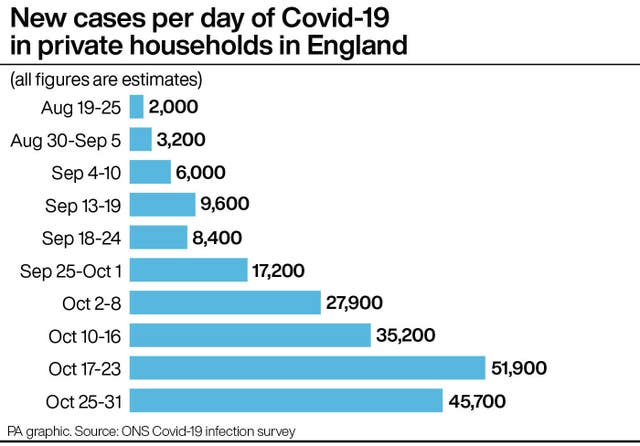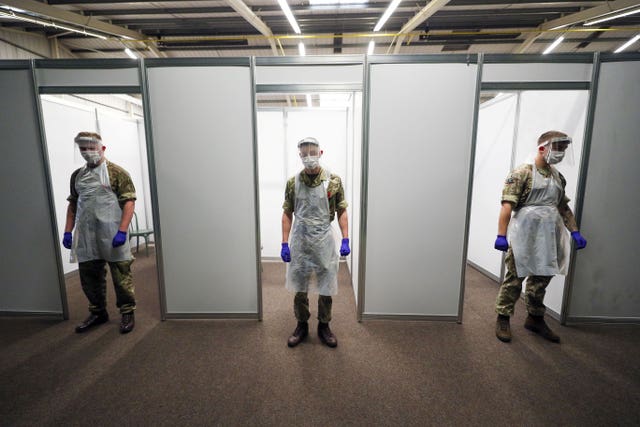Covid-19 infection rate appears to be slowing down – ONS
When looking at new daily infections, the ONS said the rate across England appears to have ‘stabilised’ at around 50,000 per day.

The rate of coronavirus infections across England and Wales appears to be slowing down, new data suggests.
The Office for National Statistics (ONS) said an estimated 618,700 people in England – one in 90 – had Covid-19 between October 25 and 31, up from 568,100 the week before.
But while the infection rate has increased in recent weeks, “the rate of increase is less steep compared with previous weeks”, the ONS said.

Ruth Studley, head of analysis for the Covid-19 infection survey, said: “At a national level we are seeing infections slow across England and Wales but they are still increasing.
“Within England, every region apart from the North East has shown increased levels of infection.
“The level of infection in young adults and older teenagers appears to have levelled off recently.
“However, they continue to be the most likely to be infected despite increases in all other age groups.”
When looking at new daily infections, the ONS said the rate across England appears to have “stabilised”.

There were an average of 45,700 new cases per day of Covid-19 in private homes between October 25 and 31, down from an estimated 51,900 new cases per day for the period from October 17 to 23.
This suggests the rate of new infections “appears to have stabilised in recent weeks at around 50,000 new infections per day”, the ONS said.
The figures do not include people staying in hospitals or care homes and are based on more than 689,000 swab tests gathered from across the UK in people with and without symptoms.
It comes as 64,170 deaths involving Covid-19 have now occurred in the UK, according to figures produced by statistical agencies.
Elsewhere:
– The Government said a further 355 people had died within 28 days of testing positive for Covid-19 as of Friday. There were also a further 23,287 lab-confirmed cases of coronavirus in the UK as of 9am.
– The University Hospitals Birmingham NHS Foundation Trust (UHB) said the Queen Elizabeth Hospital has been forced to postpone all planned procedures after a sharp rise in Covid-19 and non-Covid-19 emergency cases. Some 359 hospital beds were occupied by confirmed Covid-19 patients on November 3.
– Denmark has been taken off the UK’s coronavirus travel corridor list, meaning anyone arriving in the UK from Friday will need to self-isolate for 14 days.
– City-wide mass testing has got under way in Liverpool in the first pilot study of its kind. Everyone living or working in Liverpool – including children – will be offered repeat tests, whether or not they have symptoms.

On Friday, the Scientific Advisory Group for Emergencies (Sage), which advises the Government, said the reproductive rate – the R value – of coronavirus transmission for the whole of the UK remains at between 1.1 and 1.3.
It said: “Sage is confident that the epidemic has continued to grow in England over recent weeks.
“Although there is some evidence that the rate of growth in some parts of the country may be slowing, levels of disease are very high in these areas and significant levels of healthcare demand and mortality will persist until R is reduced to and remains well below 1 for an extended period of time.”
The Zoe Covid Symptom Study app, run by King’s College London, suggests there were 42,049 daily new symptomatic cases of Covid-19 in the UK on average over the two weeks up to November 1 (excluding care homes).
Researchers behind that study said the UK R rate is currently 1.0, and 1.0 in England.
Tim Spector, professor of genetic epidemiology at King’s, said daily cases were falling in the north of England and Scotland, and cases overall were moving in the “right direction”.
He said they were a “positive sign that we have passed the peak of this second wave”, adding: “We urge everyone to respect the restrictions and help get the number of cases down as soon as possible to help the NHS, end the lockdown and get us in good shape for December.”
Earlier, James Naismith, professor of structural biology at Oxford University, told BBC Radio 4’s Today programme that NHS Test and Trace had made no difference to the spread of Covid-19.
Data shows the system reached just 59.9% of close contacts of people who tested positive for coronavirus in the week ending October 28.
Prof Naismith said: “It hasn’t been effective at all. The only ways we are currently able to control infection spreading are social restrictions.
“Tracking and tracing hasn’t really made any difference to the spread of the epidemic.”
Commenting on the new ONS and King’s College data, Prof Naismith said they provided “evidence that the social restrictions prior to lockdown have had a real impact.
“Should we be at or past the peak of infections, then I would not expect the death rate to exceed 1,000 a day for any prolonged period.
“However, we are still very likely to face daily death tolls of 500 a day for a period in November.”
He said if next week’s data showed a similar stabilisation or reduction, “then we can be confident that the second wave has for now stabilised.”
The new national lockdown should also “bring a rapid decrease in the number of new infections,” he said.

On Thursday, Boris Johnson insisted that four weeks of national lockdown should be enough to drive down the spread of coronavirus so severe restrictions can be eased.
As England was plunged into a second shutdown, the Prime Minister acknowledged many people were “anxious, weary and fed up” but continued to express optimism that science would succeed in finding a way out of the crisis.
But some scientists said coronavirus cases need to come down to 5,000 a day so NHS Test and Trace can cope.
Independent Sage said there needs to be an exit strategy from lockdown and called for urgent reform of Test and Trace in order to “avoid continual lockdowns”.
Professor Anthony Costello, of University College London, said: “Failure to reform and improve the performance of the find, test, trace and isolate system, will mean earlier and more frequent circuit breakers and lockdowns.”





